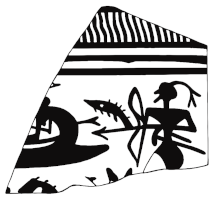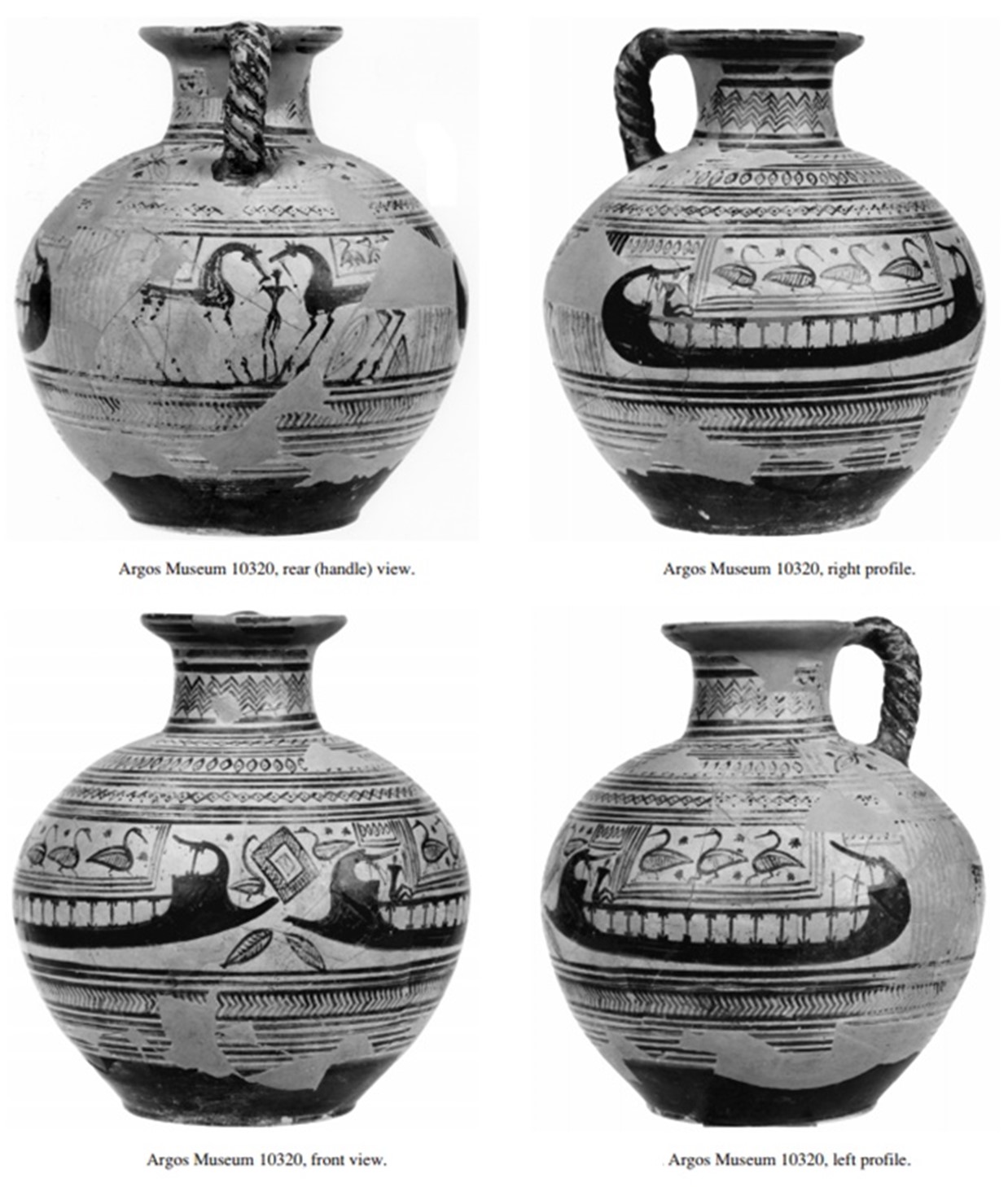Two identical single-levelled ships except for the placement of the lone figure and the presence of an additional rowing room on the left ship. Low flat hull, massive square bow with a concave post integrating an upward curving bow projection and terminating in a horn that curves backwards, nearly parallel to the hull. The high incurving sternpost terminates in an identical horn. Unlike the Attic devices which have smooth curves, these horns have a sort of rib midway, after which they switch direction into a concave curve. The fore- and aftercastle are painted as solid squares, without railing on top. There are fifteen and fourteen rowers' rooms delineated respectively, depicted by stanchions represented by short vertical lines joining the gunwale to the hull. Each of these stanchions is capped at both ends by a device resembling horns of consecration. Two more identical stanchions connect the fore- and aftercastles to the stem and sternpost horns. No tholepins are shown. A single figure is depicted seated on the upper horizontal. This figure is rendered in an identical manner on each ship, except for its placement at the stern of the left vessel, whereas it sits at the bow of the right one.
Two single-levelled galleys
A129
c. 750 B.C. (very end of MG II/ beginning of LGI)
Warrior's cist grave, Gounari street, Argos
Globular oenochoe with a rope handle of local manufacture. Reddish-brown glaze
Argos Museum 10320
Pappi 2006: 232-33, figs. 2-5
The vase was found on top of the slabs covering the cist grave of a warrior alongside a large belly-handled amphora with a hole in its base for libations, and an iron sword and dagger. The naval scene occupies the entirety of the figured zone on the belly, while the panel beneath the handle shows the "master of horses" theme which is a hallmark of the Argive repertoire. The space above the two ships is filled by three and four birds respectively, enclosed within a triple frame. Additional motifs are interspersed in the spaces around the ships. These include two water birds with long curved necks perched on the bow projection (left ship) and atop the stempost (right ship), as well as two fish below the bow projections. The latter indicate that the ships are afloat rather than beached.
One of the rare Argive ship depictions. The ships are painted neatly but in a minimalist manner: no tholepins, rowers or oars are shown. The capping devices of the stanchions are thus far unique in geometric art. The number of galleries on the left ship suggests these are triaconters, as it could be surmised that the omission of the 15th room on the right ship isn't meant to be indicative since the ships are otherwise identical. Likewise the lone figure should probably be read as the helmsman on both ships, with the artist placing it on the left end of the ships, ignoring the fact that the right one faces in the opposite direction. The horn devices resemble the ship obeloi which are also from Argos, and are much closer in resemblance to what Wachsmann would define as a stylized bird-headed device.
Pappi, E. 2006. “Argive Geometric Figured Style: the Rule and the Exception,” in E. Rystedt and B. Wells (eds.) Pictorial Pursuits: Figurative Painting on Mycenaean and Geometric Pottery. Paper from Two International Round-Table Conferences on Mycenaean and Geometric Pottery at the Swedish Institute at Athens in 1999 and 2001. Stockholm: Svenska Instituted I Athen, pp. 229-299.





